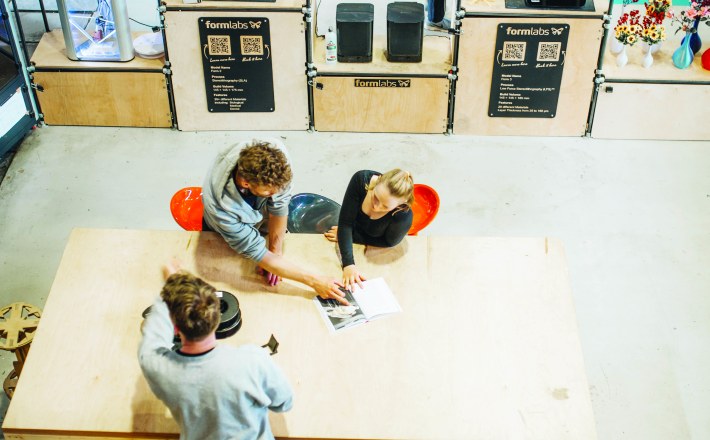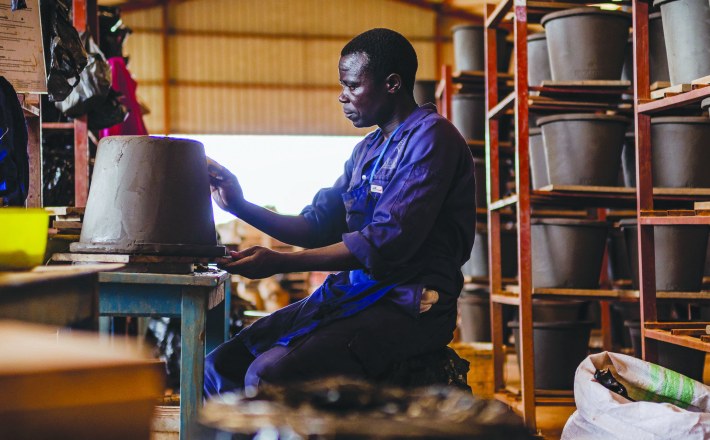Catwalk Disruptors
Fashion-insider, Michelle Duguid explores the fight for diversity and sustainability in fashion and the brave designers, models and magazine editors on a mission to shake things up
There’s a storm brewing within the fashion industry. A wind of change is challenging the status quo, heralding in the progressive new. An exciting wave of fashion disruptors offer fresh eyes on the way we work in the industry, challenging and changing perceptions for the better. They are pushing creative boundaries with the type of work they are presenting and how they show their work, allowing their cultural references to inspire. Most importantly, they demand total inclusivity on who is representing their work.
Diversity is the practice of including or involving people from a range of different social and ethnic backgrounds, genders, sexual orientation and body types. Historically the industry has been criticised for lack of exactly this, and many fashion brands and retailers are now three years on from the commitments they made to diversity, equity and inclusion (DEI) when the Black Lives Matter movement galvanised attention.

Many brands make grand statements but it is the powerful work by emerging designers that are actually pushing to address historic imbalances in the fashion industry and also proudly offer different cultural reference pots. Grace Wales Bonner has a sold-out Adidas Originals collab inspired by the Jamaican Dancehall culture which is an ongoing theme for her. Saul Nash offers brilliant genderless sportswear collections inspired by the mix of different people he grew up around. Tolu Coker’s corseted elegance looks at the matriarchs who have carved paths in England and Nigeria. Menswear designer and founder of Labrum, Foday Dumbuya, mixes British tailoring with a West African design, and Bianca Saunders collection is always a conversation around the idea of black masculinity and Caribbean identity. While these designers have found great success recently, much more representation is needed to implement systemic changes in the fashion industry.
Edward Enninful, the outgoing Editor-in-Chief of British Vogue and soon-to-be global creative and cultural advisor of Vogue, has changed what a glossy fashion magazine looks like. It now has all types of diversity represented on the cover and hats off to the casting director for her important work on fashion shoots too. Vogue and Glamour alike have also celebrated people of all genders and disabled bodies on their recent covers. “For too long there has been a lack of diversity when it comes to genders and disabilities on magazine covers,” said Deborah Joseph the European Editorial Director of Glamour. “It was important to me as editor of Glamour to say to a broad spectrum of people, we see you, we are for you, and we tell your life stories. It’s important that the next generation grow up feeling that they could be on a magazine cover regardless of who they are and what they look like - and also because of it.” Champions for diversity in fashion have also emphasised the importance of casting disabled models. Unhidden Clothing is the first adaptive brand to show at London Fashion Week, and it specialises in fashion for disabled people. (Adaptive fashion can be a lot of different things - such as clothing with sensory-friendly seams, hassle-free fastenings and design silhouettes specially created for wheelchair users.) This season it showcased clothing made for three body types: short stature, seated and ambulatory. Models walked and rolled down the catwalk and among them were actors Adam Pearson and model Ellie Goldstein who recently helped to launch Barbie's first doll representing someone with Down’s Syndrome. “There’s an assumption that disabled people don’t need any other forms of clothing except leisurewear,” says Victoria Jenkins, founder of the Unhidden brand. “Disabled people want colour and print, and to shop like anyone else.”

While designers such as Sinead O’Dwyer and Collina Strada have also been praised for casting disabled models including wheelchair users, in recent shows, research in The Guardian newspaper has found that despite representing 24% of the population, models with visible disabilities feature in only 0.02% of fashion campaigns. Lauren Nathan-Lane is a disabled model represented by Zebedee Talent. She has modelled on campaigns for major high street brands and numerous fashion editorial shoots. Lauren campaigns for the inclusion of more disabled people in the fashion industry and also works as an anti-racism and justice worker for a youth charity. She posed the question in response to these stats, “So what is it about visibility of disability that puts designers off? I think those of us who are models with visible disabilities tend to get told that our disabilities or, more specifically, our mobility aids are too distracting for fashion shows or campaigns which I think is an interesting way to view us. We obviously don’t want to distract from people looking at the clothes, but I personally think watching clothes move down a catwalk on various different bodies, including on models using mobility aids or with prosthetic limbs or oxygen tanks, actually makes the show (and in turn the clothes) more likely to stand out.”
There are a lot more important conversations currently happening around the fashion industry, powdered by social media and the democratisation of fashion, and the ability for us to use our voices for change. A report by Vogue Business, which analysed 9,584 looks across 230 presentations in New York, London, Milan and Paris, also found a massive discrepancy between the casting of different size models. New York fashion week has always been more inclusive than Paris and Milan with 33 brands on the schedule showing a wider casting. In the European cities, only 3.9 per cent of models were mid-size (UK 10-14). Therefore, 95.2 per cent of models were size UK 4-8.

Thankfully some designers are diversifying, now casting models of all sizes into their mainstream runway shows alongside traditional-size models. This approach is a powerful statement, showcasing that fashion is for everyone, regardless of body size. “We need to have more curves on the runway too and for this to be normal” said Ashley Graham to The Times newspaper after the opening of the Karoline Vitto show in Milan in September. Brazilian-born, London-based Vitto fitted her latest collection on a line of models sized between 10 and 26 which is a really intricate process as opposed to casting regular size models where one size of sample pretty much fits all. The designer is determined that this is the way she showcases her collection and stands at the forefront of a new guard of designers looking to transform fashion and the way it makes clothes for women of all shapes. Karoline Vitto and Chopova Lowena ranked joint first with 100 per cent size diversity, meaning all of the models were either mid-size (UK 10-14) or plus-size (UK 18+).
Sinead O’Dwyer is a Dublin-born fashion designer also known for her work challenging the usual casting in the fashion industry, particularly with body diversity. She has gained recognition for her commitment to inclusivity and for featuring diverse body types in her shows from the beginning of her career. We often speak on the lack of size inclusion in fashion and often blame the designers themselves, but Sinead spoke a lot about how designing for a larger figure isn’t made easy when you are starting, and even as far back as the education system. There is a standard type of mannequin and all the equipment and patterns are based on a small sample size figure. She also explains how making a collection in a wide range of sizes is difficult. She has to make four different sample sizes so four different pattern blocks which need to be graded to fit, which is very expensive for a new designer.

Disabled people want colour and print, and to shop like anyone else
It wasn’t just who was on the catwalk that was important this season, but also what was being shown and how it was being shown. As the fashion industry’s best-known sustainability guardian, Stella McCartney chose to show her new collection alongside a traditional French market, curated with 21 stands from fellow eco pioneers. Stella’s collection was made from 95% conscious materials and these small brands who supplied her yarns and dead stock were celebrated and gained important access to the fashion press. Without such a high profile designer pushing for change, would people take notice? These brands included LVMH-owned dead stock circular platform Nona Source, vegan apple waste leather supplier Mabel Industries; plant-based leather manufacturer Natural Fiber Welding and traceable wool supplier Nativa. Other stalls hinted at the mood of the market including a vintage clothes stall and vintage record stall that stocked some of Stella’s famous dad’s vinyl.
Rising stars like Conner Ives, Ahluwalia and Chopova Lowena have also embraced the idea of upcycling, creating new garments out of old - tackling the fashion industry’s environmental impact. Patrick McDowell only used sustainable fabrics for his latest catwalk show. Old garment bags were transformed into capes, and three looks were made from 170 dead stock Lee jeans. This is very labour intensive and his team took over 150 hours to repurpose the denim into a puffball skirt, patchwork blazer and a jacket.

Long-established designers are also following Erdem who incorporated antique textiles from Chatsworth house into his catwalk looks. Debo, the late Duchess of Devonshire, was a strict proponent of ‘make do and mend’, and her reworked Barbour jacket was a triumph. Andreas Kronthaler also went through Vivienne Westwood’s archives to pull out key pieces that inspired him and he remade 39 looks this way. It wasn’t just on the catwalk that recycling played its part, but also on the sets designed to show the clothes off. French designer, Nicolas Ghesquiere from Louis Vuitton teamed up with American production designer James Chinlund to install an inflatable balloon-like structure which was made from 100% recycled and recyclable material. The interior of the building was basked in a glowing vibrant orange which was the perfect backdrop for the beautiful collection.
Though the pace of change is slow, the fashion disrupters are disrupting in highly positive and creative way. Support them where you can.
AI disrupters
Artificial intelligence also played a part in fashion month as an innovation disruptor. According to McKinsey & Company in an article in Forbes, generative AI could add between $150 billion to $275 billion to the apparel, fashion, and luxury sectors’ operating profits. This has such potential with supply chain and logistics but as such the creative impact is on the fence. Ganni’s collection was inspired by the rise of AI and its design brief was set by ChatGPT. While the design team didn’t follow all of the brief, it was seen as a starting point. Ganni CEO & Creative Director, Ditte Reffstrup told Vogue, “The first reaction was 'I might not have a job tomorrow'.” Collina Strada seemed to be the first designer to actually show looks that have been physically designed by generative AI. Hillary Taymour, creative director at Collina Strada, and her team fed the previous collections into the AI model. The algorithm initially provided design ideas that were not strong enough, so it took a human touch from the design team to make it better and back on track for the brand.
Sebastian Meyer and Arnaud Vaillant from Coperni have become a big noise in fashion by cleverly offering contemporary fashion with a fascination with technology. Do you remember they showed Bella Hadid being spray painted into a dress? This time the brand worked with a tech start-up to design a prototype AI enabled pin. This is intended to be worn as you go about daily activities and it uses a multitude of sensors to enable intuitive computing interactions. Coperni also showed their signature Swipe bag reinterpreted as a Walkman.





